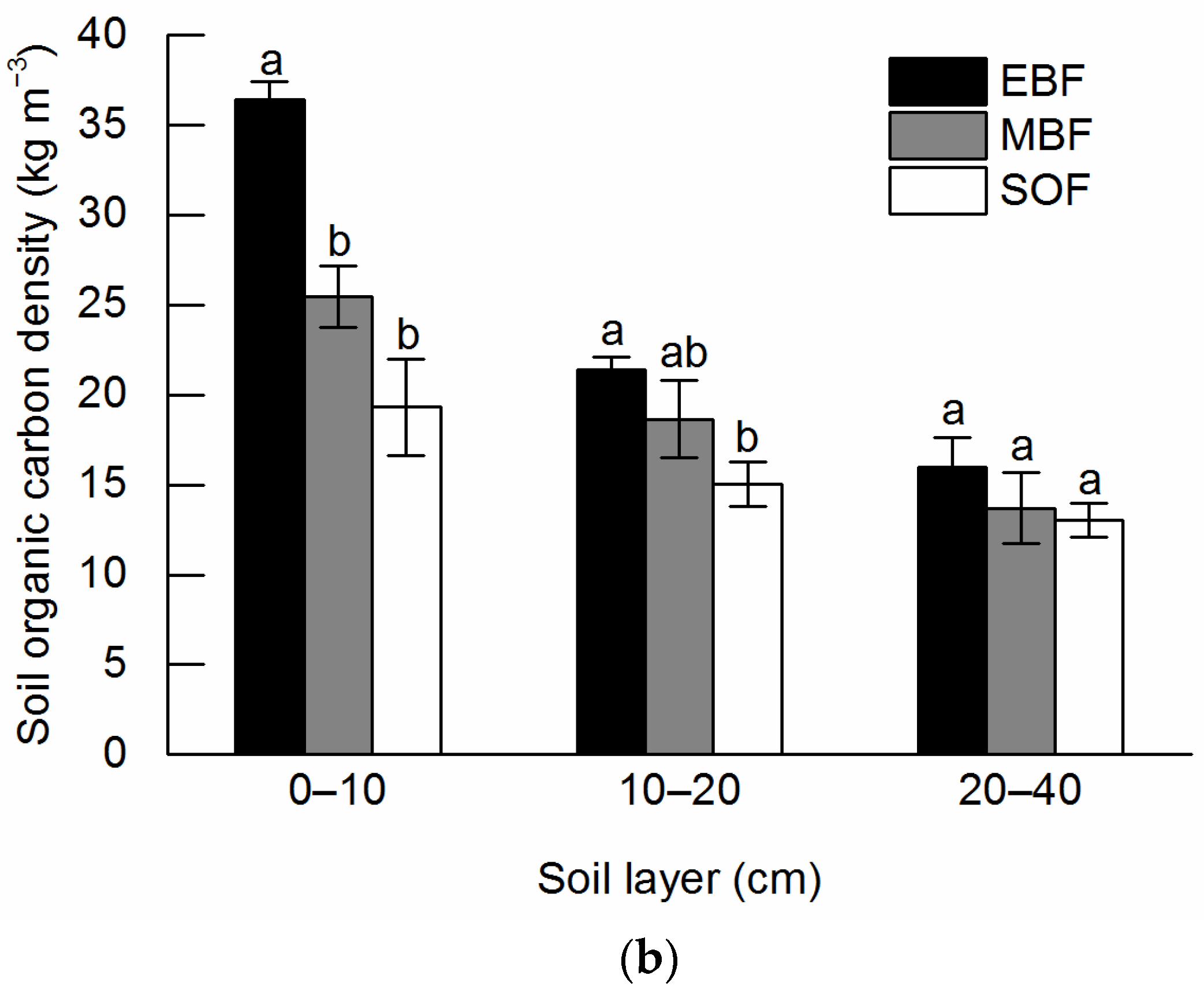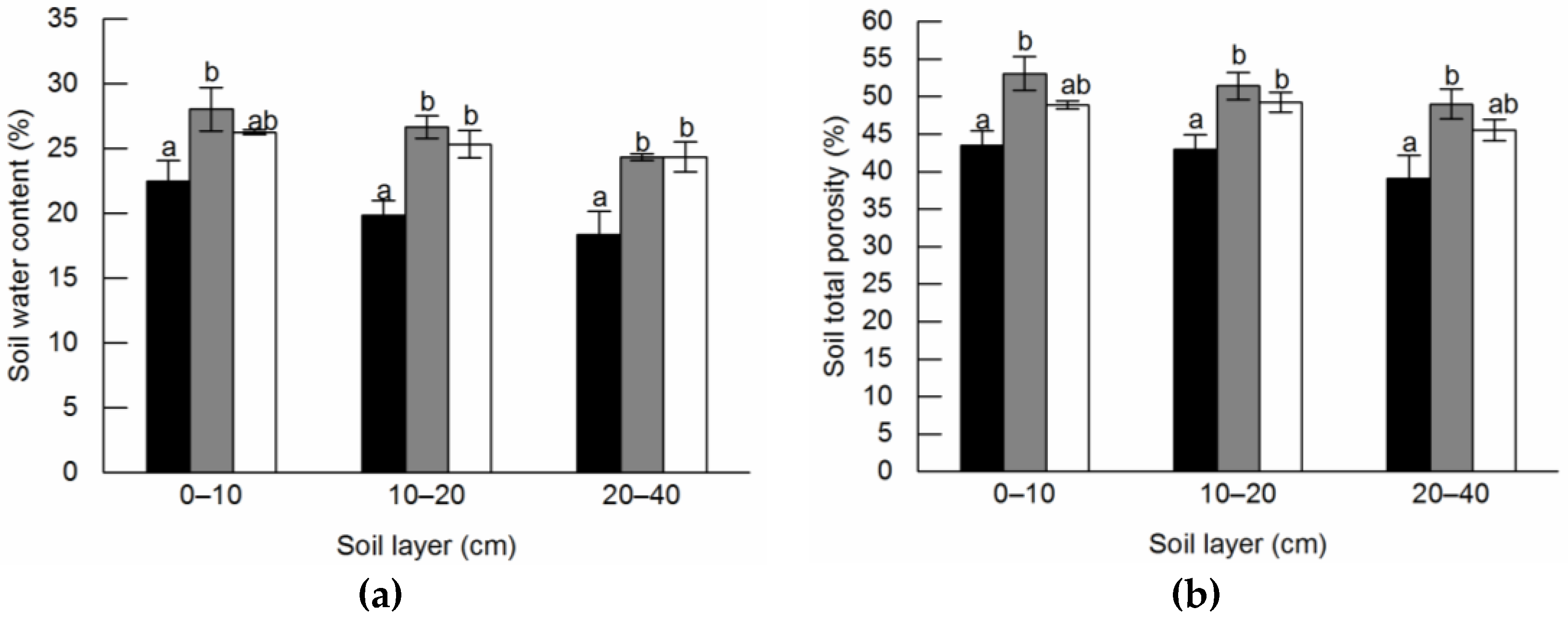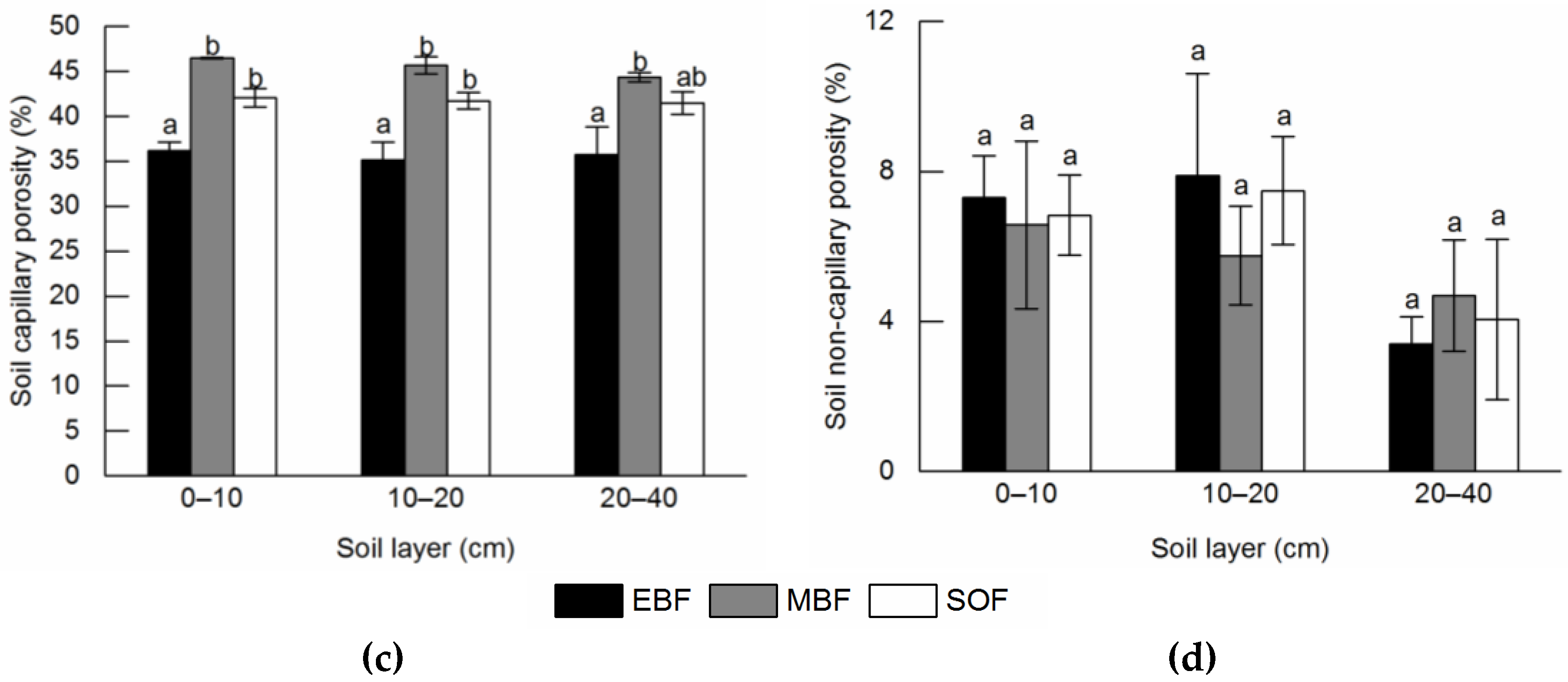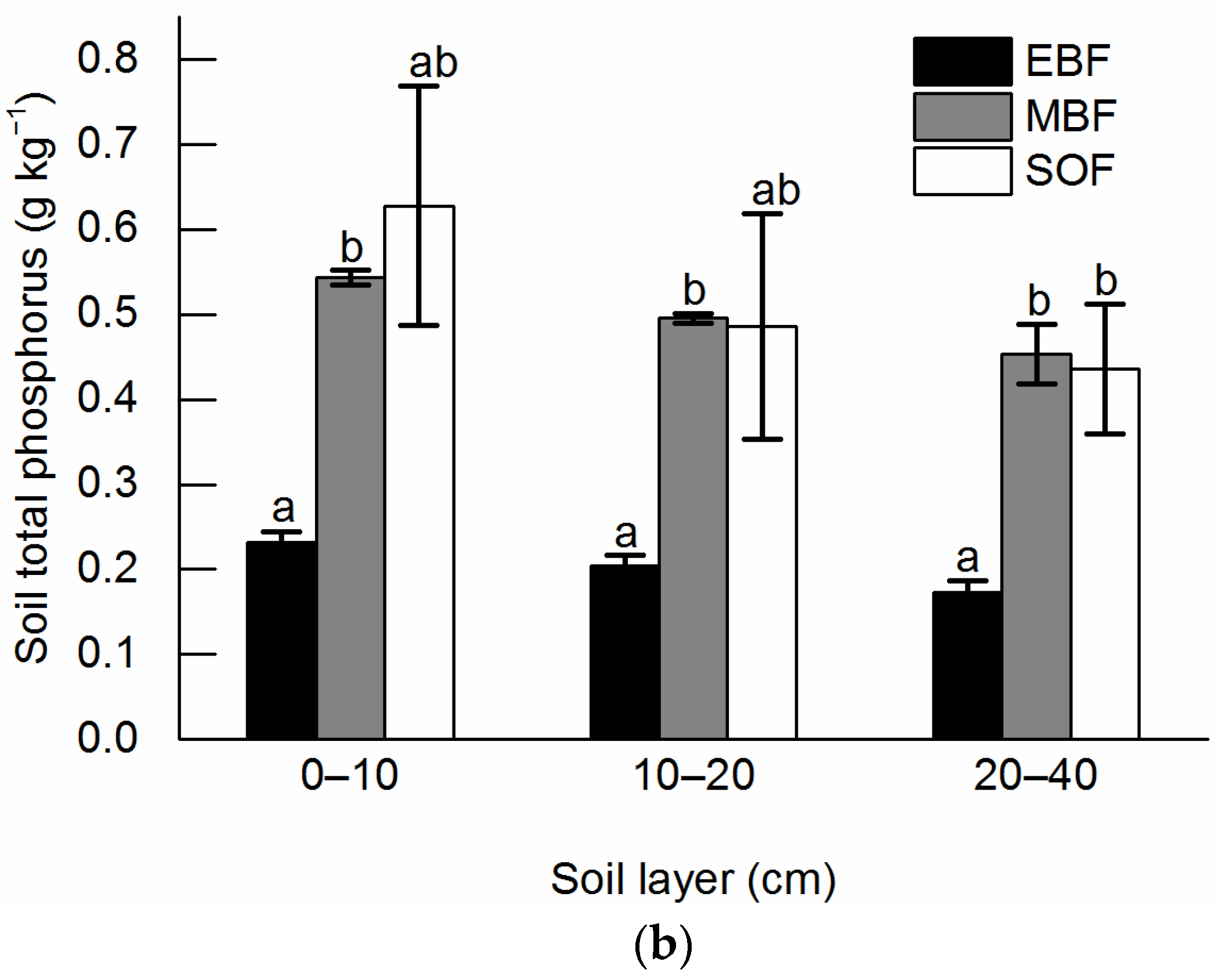Effects of Forest Conversion on Soil Ecosystem Services in Liuxihe National Forest Park, China
Abstract
:1. Introduction
2. Materials and Methods
2.1. Study Region
2.2. Soil Sampling and Laboratory Analysis
2.3. Data Analysis
3. Results
3.1. Carbon Sequestration
3.2. Water Conservation
3.3. Nutrient Accumulation
4. Discussion
4.1. Effects of Forest Conversion on Soil Ecosystem Services
4.2. Trade-Offs of Soil Ecosystem Services
4.3. Implications for Forest Management
4.4. Limitations
5. Conclusions
Author Contributions
Funding
Institutional Review Board Statement
Informed Consent Statement
Data Availability Statement
Acknowledgments
Conflicts of Interest
References
- Dominati, E.; Patterson, M.; Mackay, A. A framework for classifying and quantifying the natural capital and ecosystem services of soils. Ecol. Econ. 2010, 69, 1858–1868. [Google Scholar] [CrossRef]
- Adhikari, K.; Hartemink, A.E. Linking soils to ecosystem services—A global review. Geoderma 2016, 262, 101–111. [Google Scholar] [CrossRef]
- Post, W.M.; Kwon, K.C. Soil carbon sequestration and land-use change: Processes and potential. Glob. Chang. Biol. 2000, 6, 317–327. [Google Scholar] [CrossRef] [Green Version]
- Liu, S.R.; Wang, H.; Luan, J.W. A review of research progress and future prospective of forest soil carbon stock and soil carbon process in China. Acta Ecol. Sin. 2011, 31, 5437–5448. [Google Scholar]
- Wei, X.R.; Shao, M.A.; Gale, W.; Li, L.H. Global pattern of soil carbon losses due to the conversion of forests to agricultural land. Sci. Rep. 2014, 4, 4062. [Google Scholar] [CrossRef] [Green Version]
- Cram, S.; Sommer, I.; Fernandez, P.; Galicia, L.; Rios, C.; Barois, I. Soil natural capital modification through landuse and cover change in a tropical forest landscape: Implications for management. J. Trop. For. Sci. 2015, 27, 189–201. [Google Scholar]
- Fujisaki, K.; Perrin, A.-S.; Desjardins, T.; Bernoux, M.; Balbino, L.C.; Brossard, M. From forest to cropland and pasture systems: A critical review of soil organic carbon stocks changes in Amazonia. Glob. Chang. Biol. 2015, 21, 2773–2786. [Google Scholar] [CrossRef] [Green Version]
- Winowiecki, L.; Vagen, T.-G.; Huising, J. Effects of land cover on ecosystem services in Tanzania: A spatial assessment of soil organic carbon. Geoderma 2016, 263, 274–283. [Google Scholar] [CrossRef] [Green Version]
- Yang, Y.H.; Shi, Y.; Sun, W.J.; Chang, J.F.; Zhu, J.X.; Chen, L.Y.; Wang, X.; Guo, Y.P.; Zhang, H.T.; Yu, L.F.; et al. Terrestrial carbon sinks in China and around the world and their contribution to carbon neutrality. Sci. China Life Sci. 2022, 65, 861–895. [Google Scholar] [CrossRef]
- Dixon, R.K. Carbon pools and flux of global forest ecosystems. Science 1994, 265, 171. [Google Scholar] [CrossRef] [PubMed]
- Guillaume, T.; Kotowska, M.M.; Hertel, D.; Knohl, A.; Krashevska, V.; Murtilaksono, K.; Scheu, S.; Kuzyakov, Y. Carbon costs and benefits of Indonesian rainforest conversion to plantations. Nat. Commun. 2018, 19, 2388. [Google Scholar] [CrossRef] [Green Version]
- Celentano, D.; Rousseau, G.X.; Engel, V.L.; Zelarayán, M.; Oliveira, E.C.; Araujo, A.C.M.; Moura, E.G. Degradation of riparian forest affects soil properties and ecosystem services provision in Eastern Amazon of Brazil. Land Degrad. Dev. 2017, 28, 482–493. [Google Scholar] [CrossRef]
- Guo, L.B.; Gifford, R.M. Soil carbon stocks and land use change: A meta analysis. Glob. Chang. Biol. 2002, 8, 345–360. [Google Scholar] [CrossRef]
- Wang, Y.; Chen, L.; Xiang, W.H.; Ouyang, S.; Zhang, T.D.; Zhang, X.L.; Zeng, Y.L.; Hu, Y.T.; Luo, G.W.; Kuzyakov, Y. Forest conversion to plantations: A meta-analysis of consequences for soil and microbial properties and functions. Glob. Chang. Biol. 2021, 27, 5643–5656. [Google Scholar] [CrossRef]
- Straaten, O.V.; Corre, M.D.; Wolf, K.; Tchienkoua, M.; Cuellar, E.; Matthews, R.B.; Veldkamp, E. Conversion of lowland tropical forests to tree cash crop plantations loses up to one-half of stored soil organic carbon. Proc. Natl. Acad. Sci. USA 2015, 112, 9956–9960. [Google Scholar] [CrossRef] [Green Version]
- Song, X.; Kimberley, M.O.; Zhou, G.M.; Wang, H.L. Soil carbon dynamics in successional and plantation forests in subtropical China. J. Soils Sediments 2017, 17, 2250–2256. [Google Scholar] [CrossRef]
- Yang, Y.S.; Xie, J.S.; Sheng, H.; Chen, G.S.; Li, X. The Impact of Land Use/Cover Change on Soil Organic Carbon Stocks and Quality in Mid-subtropical Mountainous Area of Southern China. Acta Geogr. Sin. 2007, 62, 1123–1131. [Google Scholar]
- Hu, Y.L.; Wang, S.L.; Yan, S.K.; Gao, H. Effects of replacing natural secondary broad-leaved forest with Cunninghamia lanceolata plantation on soil biological activities. J. Appl. Ecol. 2005, 16, 1411–1416. [Google Scholar]
- He, S.X.; Li, X.Y.; Mo, F.; Zhou, B.; Gao, G.L. The water conservation study of typical forest ecosystems in the forest transect of eastern China. Acta Ecol. Sin. 2011, 31, 3285–3295. [Google Scholar]
- Liu, S.R.; Sun, P.S.; Wen, Y.G. Comparative analysis of hydrological functions of major forest ecosystems in china. Acta Phytoecol. Sin. 2003, 27, 16–22. [Google Scholar]
- Wen, Z.; Zhao, H.; Liu, L.; Li, Y.M.; Mi, H.X.; Ouyang, Z.Y.; Zheng, H. Effects of intercropping with Alpinia oxyphylla in rubber plantation on soil water conservation function. Chin. J. Ecol. 2018, 37, 3179–3185. [Google Scholar]
- Mo, F.; Li, X.Y.; He, S.X.; Wang, X.X. Evaluation of soil and water conservation capacity of different forest types in Dongling Mountain. Acta Ecol. Sin. 2011, 31, 5009–5016. [Google Scholar]
- Zeng, X.M.; Gao, J.T.; Fan, Y.X.; Yuan, P.; Bao, Y.; Gao, Y.; Zhao, P.P.; Si, Y.T.; Chen, Y.M.; Yang, Y.S. Effect of soil factors after forest conversion on the accumulation of phosphorus species in mid-subtropical forests. Acta Ecol. Sin. 2018, 38, 4879–4887. [Google Scholar]
- He, G.X.; Wang, Y.; Peng, S.X.; Guo, Z.L.; Liu, C.E.; Fu, D.G.; Duan, C.Q. Soil carbon, nitrogen and phosphorus stocks and ecological stoichiometry characteristics of different vegetation restorations in degraded mountainous area of central Yunnan, China. Acta Ecol. Sin. 2020, 40, 4425–4435. [Google Scholar]
- de, B.M.; Brumme, R.; Xu, J.C.; Corre, M.D.; Veldkamp, E. Soil carbon stocks decrease following conversion of secondary forests to rubber (Hevea brasiliensis) plantations. PLoS ONE 2013, 8, e69357. [Google Scholar]
- Jobbágy, E.G.; Jackson, R.B. The vertical distribution of soil organic carbon and its relation to climate and vegetation. Ecol. Appl. 2000, 10, 423–436. [Google Scholar] [CrossRef]
- Feng, J.Y.; Chu, S.S.; Wang, J.; Wu, D.M.; Mo, Q.F.; Gao, J.; Lin, J.H.; Zeng, S.C. Soil organic carbon density and its relationship with soil physical properties of typical plantations in South China. J. S. China Agric.Univ. 2018, 39, 83–90. [Google Scholar]
- Liu, G.L.; Zhang, D.H. Progresses in research on subtropical forest ecosystem soil organic carbon cycle. Wuyi Sci. J. 2007, 23, 234–240. [Google Scholar]
- GSCO. Guangdong Soil; Science Press: Beijing, China, 1993; pp. 171–173. [Google Scholar]
- Calzolari, C.; Ungaro, F.; Filippi, N.; Guermandi, M.; Malucelli, F.; Marchi, N.; Staffilani, F.; Tarocco, P. A methodological framework to assess the multiple contributions of soils to ecosystem services delivery at regional scale. Geoderma 2016, 261, 190–203. [Google Scholar] [CrossRef]
- Guillaume, T.; Damris, M.; Kuzyakov, Y. Losses of soil carbon by converting tropical forest to plantations: Erosion and decomposition estimated by δ(13) C. Glob. Chang. Biol. 2015, 21, 3548–3560. [Google Scholar] [CrossRef]
- Zheng, H.; Ouyang, Z.Y.; Xu, W.H.; Wang, X.K.; Miao, H.; Li, X.Q.; Tian, Y.X. Variation of carbon storage by different reforestation types in the hilly red soil region of southern China. For. Ecol. Manag. 2008, 225, 1113–1121. [Google Scholar] [CrossRef]
- Ubuoh, E.A.; Nwankama, C.; Ejekwolu, C.C. The Effect of Selected Land Uses on Soil Organic Carbon (Soc) and Total Nitrogen (Tn) Dynamics in Imo State, Nigeria (Carbon Sequestration Implications). Acad. J. Env. Sci. 2016, 4, 220–226. [Google Scholar]
- Amanuel, W.; Yimer, F.; Karltun, E. Soil organic carbon variation in relation to land use changes: The case of Birr watershed, upper Blue Nile River Basin, Ethiopia. J. Ecol. Env. 2018, 42, 128–138. [Google Scholar] [CrossRef]
- Sun, H.; Liu, X.Y.; He, Q.; Jiang, L.C.; Xu, X. Assessments of Four Types of Forests on Soil Water Conservation Functions in the Upper Reaches of Xiu River. Res. Soil Water Conserv. 2017, 24, 337–341. [Google Scholar]
- Van, N.M.; Cerri, C.; Woomer, P.L.; Nugroho, K.; Bernoux, M. Soil carbon dynamics in the humid tropical forest zone. Geoderma 1997, 79, 187–225. [Google Scholar]
- Yonekura, Y.; Ohta, S.; Kiyono, Y.; Aksa, D.; Morisada, K.; Tanaka, N.; Kanzaki, M. Changes in soil carbon stock after deforestation and subsequent establishment of “Imperata” grassland in the Asian humid tropics. Plant Soil 2010, 329, 495–507. [Google Scholar] [CrossRef]
- Luskin, M.S.; Potts, M.D. Microclimate and habitat heterogeneity through the oil palm lifecycle. Basic Appl. Ecol. 2011, 12, 540–551. [Google Scholar] [CrossRef]
- Liao, C.Z.; Luo, Y.Q.; Fang, C.M.; Chen, J.K.; Li, B. The effects of plantation practice on soil properties based on the comparison between natural and planted forests: A meta-analysis. Global Ecol. Biogeogr. 2012, 21, 318–327. [Google Scholar] [CrossRef]
- Sharma, S.K.; Baral, H.; Pacheco, P.; Laumonier, Y. Assessing impacts on ecosystem services under various plausible oil palm expansion scenarios in central Kalimantan, Indonesia; CIFOR: Bogor Regency, Indonesia, 2017; Volume 176, pp. 1–8. [Google Scholar]
- Dai, E.F.; Wang, X.L.; Zhu, J.J.; Xi, W.M. Quantifying ecosystem service trade-offs for plantation forest management to benefit provisioning and regulating services. Ecol. Evol. 2017, 7, 7807–7821. [Google Scholar] [CrossRef]
- Su, C.H.; Liu, H.F.; Wang, S.A. A process-based framework for soil ecosystem services study and management. Sci. Total Environ. 2018, 627, 282–289. [Google Scholar] [CrossRef]
- Chen, T.Q.; Gao, Y.; Feng, Z.; Yang, Y.; Wu, K.N.; Zhao, H.F. Hotspots and trends of soil ecosystem services based on CiteSpace. J. China Agric.Univ. 2021, 26, 204–219. [Google Scholar]
- Zhou, D.X.; Lin, Y.B.; Wang, Y.J.; Liu, Z.F.; Zhou, L.X. Assessment of Main Ecosystem Services in Subtropical Plantations. Ecol. Env. Sci. 2021, 30, 907–919. [Google Scholar]
- Ou, Z.R.; Sun, Y.Y.; Deng, Z.H.; Feng, D.F. Trade-offs in forest ecosystem services: Cognition, approach and driving. Sci. Soil Water Conserv. 2020, 18, 150–160. [Google Scholar]
- Wen, Z.; Wu, J.E.; Yang, Y.Z.; Li, R.N.; Ouyang, Z.Y.; Zheng, H. Implementing intercropping maintains soil water balance while enhancing multiple ecosystem services. Catena 2022, 217, 106426. [Google Scholar] [CrossRef]
- Chen, B.F.; Pan, Y.J.; Shi, X.; Xiao, Y.H.; Xu, M. Ecological characteristics of density and reserves of organic carbon in typical forest soils in Guangzhou. J. Northeast. For. Univ. 2010, 38, 59–65. [Google Scholar]
- Parhizkar, M.; Shabanpour, M.; Miralles, I.; Zema, D.A.; Lucas-Borja, M.E. Effects of plant species on soil quality in natural and planted areas of a forest park in northern iran. Sci. Total Environ. 2021, 778, 146310. [Google Scholar] [CrossRef]
- Maren, I.E.; Bhattarai, K.R.; Chaudhary, R.P. Forest ecosystem services and biodiversity in contrasting himalayan forest management systems. Environ. Conserv. 2014, 41, 73–83. [Google Scholar] [CrossRef]
- Luo, X.Z.; Hou, E.Q.; Chen, J.Q.; Li, J.; Zhang, L.L.; Zang, X.W.; Wen, D.Z. Dynamics of carbon, nitrogen, and phosphorus stocks and stoichiometry resulting from conversion of primary broadleaf forest to plantation and secondary forest in subtropical China. Catena 2020, 193, 104606. [Google Scholar] [CrossRef]
- Hu, Y.T.; Guan, D.S.; Wang, H.; Sun, L. Carbon storage of evergreen broad-leaved forest and orchard ecosystems in Guangzhou. Chin. J. Ecol. 2014, 33, 2873–2879. [Google Scholar]
- Harris, N.L.; Brown, S.; Hagen, S.C.; Saatchi, S.S.; Petrova, S.; Salas, W.; Hansen, M.C.; Potapov, P.V.; Lotsch, A. Baseline map of carbon emissions from deforestation in tropical regions. Science 2012, 336, 1573–1576. [Google Scholar] [CrossRef]
- Sasaki, N.; Myint, Y.Y.; Abe, I.; Venkatappa, M. Predicting carbon emissions, emissions reductions, and carbon removal due to deforestation and plantation forests in southeast asia. J. Clean. Prod. 2021, 312, 127728. [Google Scholar] [CrossRef]







| Type | Main Tree Species | Main Undergrowth Vegetation | Location | Elevation(m) | Slope(°) |
|---|---|---|---|---|---|
| EBF | Schima superba Castanopsis fabri Abarema clypearia | Psychotria rubra Castanopsis faberi Abarema clypearia Adiantum flabellulatum Rourea microphylla Carex chinensis | 23.747617° N, 113.794080° E | 228 | 40 |
| 23.747380° N, 113.793913° E | 240 | 34 | |||
| 23.747467° N, 113.794323° E | 253 | 38 | |||
| MBF | Phyllostachys edulis | Ficus hirta Rhaphiolepis indica Glochidion eriocarpum Lophatherum gracile Adiantum flabellulatum Dicranopteris pedata | 23.737959° N, 113.823933° E | 339 | 29 |
| 23.738152° N, 113.824166° E | 340 | 36 | |||
| 23.737956° N, 113.824332° E | 343 | 37 | |||
| SOF | Citrus reticulata | Ageratum conyzoides Oxalis corniculata Spermacoce alata | 23.736124° N, 113.825680° E | 289 | 40 |
| 23.740152° N, 113.822283° E | 350 | 28 | |||
| 23.739930° N, 113.822395° E | 342 | 31 |
| Significance | |||
|---|---|---|---|
| 0–10 cm | 10–20 cm | 20–40 cm | |
| soil organic carbon content | 0.268 | 0.028 | 0.227 |
| soil organic carbon density | 0.303 | 0.198 | 0.498 |
| soil water content | 0.109 | 0.902 | 0.203 |
| total soil porosity | 0.145 | 0.588 | 0.325 |
| soil capillary porosity | 0.050 | 0.265 | 0.142 |
| soil non-capillary porosity | 0.152 | 0.178 | 0.203 |
| soil total nitrogen | 0.071 | 0.601 | 0.470 |
| soil total phosphorus | 0.007 | 0.017 | 0.117 |
Publisher’s Note: MDPI stays neutral with regard to jurisdictional claims in published maps and institutional affiliations. |
© 2022 by the authors. Licensee MDPI, Basel, Switzerland. This article is an open access article distributed under the terms and conditions of the Creative Commons Attribution (CC BY) license (https://creativecommons.org/licenses/by/4.0/).
Share and Cite
Zhuang, C.; Zhang, X.; Han, Y.; Dong, M.; Chen, W. Effects of Forest Conversion on Soil Ecosystem Services in Liuxihe National Forest Park, China. Forests 2022, 13, 1650. https://doi.org/10.3390/f13101650
Zhuang C, Zhang X, Han Y, Dong M, Chen W. Effects of Forest Conversion on Soil Ecosystem Services in Liuxihe National Forest Park, China. Forests. 2022; 13(10):1650. https://doi.org/10.3390/f13101650
Chicago/Turabian StyleZhuang, Changwei, Xiuyu Zhang, Yu Han, Mingang Dong, and Weijie Chen. 2022. "Effects of Forest Conversion on Soil Ecosystem Services in Liuxihe National Forest Park, China" Forests 13, no. 10: 1650. https://doi.org/10.3390/f13101650




